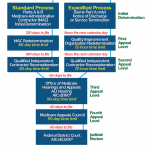In another case, Dr. Schweitz notes, a RAC sent demand letters to hundreds of Florida physicians asking for refunds or records as far back as 2003 pertaining to procedure codes 64470–64476 (facet joint injections) asserting that they must be performed and billed with a concurrent code for fluoroscopic guidance. The RACs cited commentary from the Federal Register as their authority, when no CMS policy had been developed or distributed until 2007 when a Local Coverage Determination was formally adopted and published, says Dr. Schweitz. “The main flaw in the demo project was that there was not adequate oversight by CMS. RACs were not following guidelines and were making medical necessity determinations without proper expertise,” he adds.
One-third of provider appeals (physician, hospital, and other providers) were successful during the demo program, according to a June 2008 CMS evaluation report.1
CMS has made programmatic revisions designed to ensure that the permanent RAC program avoids these demo program flaws (see “Refinements in Permanent RAC Program,” p. 20). For example, all new issues that a RAC wishes to pursue for overpayments must be validated by CMS or an independent RAC validation contractor and posted to a RAC’s Web site before widespread review.
Preparation Advice
Physicians can minimize practice disruption from RAC audits, as well as future improper payments, by taking corrective actions. The majority of improper payments under the RAC demo program stemmed from providers billing for services that were incorrectly coded or did not meet Medicare’s medical necessity policies, according to the CMS evaluation report.
The ACR is in the process of creating an Audit Toolkit for rheumatologists and their staff, and plans to have it available by January or February 2010, according to Antanya A. Chung, CPC, CPC-I, CRHC, CCP, ACR director of practice management. “We are aware of the burden that audits can bring on a practice, both financially and emotionally, and the ACR currently sends its coding and audit specialist to affiliated state society meetings to talk with physicians and their staff on current coding issues,” she says. The ACR also provides a wide variety of coding and billing resources on its Web site at www.rheumatology.org/practice.
Based on discussions with consultants, medical societies, and physicians affected by RAC audits, Dr. Schweitz offers several recommendations to prepare for RAC audits:
- Have a preset compliance plan for CMS regulations and test it by proactively reviewing a sample of your charts and charges periodically.
- If you hire a consultant, have him or her work with your practice’s attorney to ensure that the information they review is privileged to preempt an uncontrollable whistleblower scenario if errors are discovered.
- Ensure that your documentation and coding activities are detailed and in synch with CMS guidelines.
- Have some kind of disease activity measure to add objective detail to your patient medical records (e.g., the RAPID 3 to quantify a patient’s reported physical function, pain, and patient global estimate). Consider adding a self-report joint count as a fourth disease activity index.
- Designate someone in your practice as a dedicated point person to deal with the RAC; ensure that he or she maintains close communication with the practice’s physicians and administration.
- If a RAC issues a demand letter, make sure the practice was paid for those services in the first place, and make sure they have not already been adjudicated by a local Medicare carrier.
- Document every letter you receive and send when interacting with the RAC.
- If you think you’re correct, be firm and appeal as quickly as you can; if not, pay as soon as you can.
Christopher Guadagnino is a medical journalist based in Pennsylvania.

